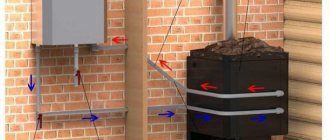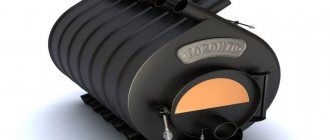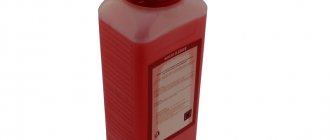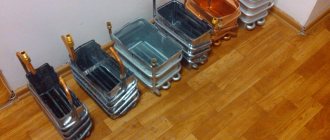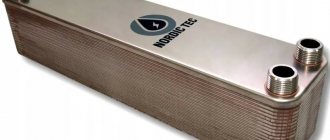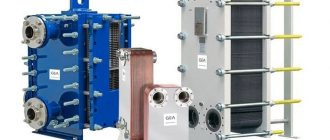This is one of the most difficult questions that customers ask us when choosing a wall-mounted boiler for their home. Typically, the average consumer, when thinking about purchasing heating equipment, is limited to the following criteria:
- Boiler power;
- Type of fuel;
- Price;
- Reliability.
But the question of the types of heat exchangers needs to be understood in more detail, which we will do in this review. We will talk about separate and bithermal heat exchangers, show their differences, and talk about the advantages and disadvantages.
Based on the information received, you will be able to form your own opinion and make the right choice regarding the model of wall-mounted heating boiler.
Purpose of bithermic heat exchanger
A biothermal heat exchanger (hereinafter referred to as BT) is a radiator equipment in which, under one housing, there are both heating chambers and containers for preparing household clean liquid. The separation of different temperature environments for their exchange is inherent in the internal system of chambers; it is not visible under the common body. It is represented by a heating chamber, which has two heating functions:
- For heating system.
- For supplying hot water supply (DHW).
This does not mean that liquid flows from one chamber further in different directions and of different quality. The operating principle is based on primary and secondary heating.
Principle of operation
Everything happens as follows:
- The heat from the plates emanates to the surface of the outer tube, and then into the heating circuit. If heating is required in winter and the hot water supply is turned off, the liquid flows only through the heating circuit, and the hot water is shut off.
- When hot water is opened, the heating circuit is closed and the hot water supply circuit is started. Heat from the external circuit and the entire heat exchanger passes to the liquid that flows through the internal cavity. The hot water tap is turned off - and the heating current is restored.
That is, only one circuit functions at a time. The second one is blocked at this moment. This principle is necessary in order to reduce the influence on the outlet temperature of the liquid from heating the coolant and vice versa. Thus, it is controlled where the heat from the gas burner or combustion of another type of fuel will go.
If you are wondering what to choose: a bithermic or separate heat exchanger, know that the first option is 10-15% cheaper and only 1-2% lower in efficiency of the second option. This occurs by reducing the amount of material consumed without complicating the technical process and by eliminating three-way valves and control valves. Perhaps this particular parameter will become fundamental for you when choosing, but still consider the pros and cons of the two designs.
The cross-section of the pipes is selected so that the fluid flow speed does not increase and the pressure does not decrease. Therefore, there is no need to even further increase the area of heat exchange with the combustion chamber.
What are the methods for cleaning and flushing the heat exchanger?
Construction device
Such equipment is also called “pipe in pipe”, “section in section”. There are two main segments in the device where liquids do not mix with each other:
- water circulation for hot water supply;
- circulation of water for heating.
Copper fins-plates are attached to the pipes, increasing the efficiency coefficients. If the boiler is gas, then it will definitely have an ignition device - a burner. Such structures will also be additionally equipped with protective layers. In addition, all such heat exchangers, no matter what modification they may be, provide highly functional insulation and protection against electric short circuits, and mandatory grounding.
How to properly install equipment
You can install such equipment either independently or with the help of boiler installation specialists. The only condition that cannot be violated is to include the boiler in the gas system itself, because such work will have to be entrusted to a specialist. Moreover, such people must have special permits and certificates. If the homeowner violates this provision, then first of all, he will be disconnected from the system, and secondly, a very large fine will be imposed. But in order to independently connect a cast-iron gas boiler, you will still need construction skills.
And such technical premises have special requirements:
The ceiling height in the boiler room must be at least 3 meters, and the room must be at least 4 square meters. meters. These parameters are suitable for an average-capacity boiler, but the larger the boiler, the more space there should be around. Usually such things are recommended by the manufacturer themselves; the presence of at least a single window, because there must be air flow. The door opening must be 80 cm wide and the gap between the floor and the door leaf must be at least 35 mm; the distance to electrical and gas installations or appliances must be at least 3.5 meters; on the floor, in the place where the cast iron boiler is planned to be installed, a cement screed is poured, and this place is reinforced with a steel plate
It is important to remember that the steel sheet must be located under the entire surface of the bottom of the heating installation, and also protrude 3-4 cm beyond its front side; With materials that have fire-resistant qualities, it is necessary to strengthen the entire part of the wall where the chimney pipe will pass.
You might be interested >> How a non-volatile gas boiler works
The main document when independently preparing a boiler for mounting it into the system should be an accompanying document in the form of instructions developed by the manufacturer.
Such a document gives parameters and regulates the procedure for connecting the boiler to the main pipeline, to the chimney system, as well as to the return and supply systems.
Operating principle
The principle of operation of bithermal equipment lies in its different modes. They can only be turned on individually and not simultaneously.
Operating mode for heating:
- The coolant is exposed to direct heating.
- Under pressure it is transferred to the receiving pipes.
- Then, circulating through the system, it returns to the exchange office.
DHW formation mode (secondary method):
- The coolant is heated in the chamber.
- From it, thermal energy is supplied to sections with domestic water.
- The heated coolant in the chamber does not enter the heating system, but is retained in its section.
System installation
Since the internal heat exchanger is connected to the system at the same time as the heating boiler, only the installation of external devices needs to be considered separately. This operation is not difficult. You just need to check that there is a thread at the inlet and outlet of the device. Otherwise, you will have to take special care in cutting it.
Connecting the heat exchanger to the network requires fixing it to the wall. If a cast iron structure is used, then the fasteners are selected with special strength. It is best to use a special console.
For insertion into the system, specific couplings are used, which will also be needed if there is a desire to provide the structure with additional water filters. In some cases, two of them are installed at once. This arrangement is used for old heating systems.
You will also need standard taps and American ones. The latter consist of two threaded fittings, a gasket and a union nut.
Advantages and disadvantages of the device
Advantages of single block radiators:
- low level of heat loss.
- Reliability of materials - there is only one connection that connects the block with the system channels.
- High efficiency of heat supply in two directions.
- The orientation of the control thermostats to a single unit provides 100% accuracy in obtaining data.
Disadvantages of bithermal radiators:
- Limited operation of the layers - liquids for supplying hot water supply and heating cannot be allowed to circulate at the same time.
- Coaxial circuits can quickly fail due to scale formation or corrosion of metal parts. Therefore, it is necessary to additionally use neutralizing inhibitors.
- Productivity is slightly reduced compared to boilers with separate blocks - for hot water supply and space heating.
terms of Use
The bithermal heat exchanger needs to be washed more often.
You should purchase a boiler with such a heat exchanger only if you are confident in the sufficiently good quality of the water used as the coolant. It is imperative to install a system of filters and softeners, because the device has low maintainability. This simple step should not be neglected in order to minimize the likelihood of needing to contact a workshop. The documentation supplied with the boiler indicates the requirements for the coolant. You need to check that the water in the area matches them.
If the exchanger fails, you must contact the service center. In practice, it sometimes turns out that repairmen take on work with such devices reluctantly and without guarantees, and in the end they have to buy a new one.
The structure easily becomes clogged with soot and limescale deposits accumulate on it. This reduces efficiency - one of its main advantages over separate options. It is advisable to periodically (every 2 years) clean the exchanger with a pressure pump. Before carrying out it, you need to consult a technical center regarding the composition of the solution and the technology of the procedure. Errors in this matter easily lead to depressurization; in such an incident, the heat exchanger needs to be replaced. It’s good if you have the opportunity to invite a specialist to your home - this will allow you to get qualified advice without dismantling the boiler.
Aggressive cleaning agents are used only in extreme cases, if softer ones do not give the desired effect.
Features of boilers with bithermic heat exchangers
The popularity of boilers with bithermic radiators is obvious today. Modern manufacturers and various leading companies use their own components (for 6 tubes) and interesting developments (smooth combustion control, cooling, etc.). For example, brands:
- Immegras, Italy;
- Protherm, Slovakia;
- Vaillant, Germany;
- Navien, Korea;
- Ferroli, Italy.
Sectional expansion allows you to increase heat transfer rates, placing the device very close to the burner with an open flame, in comparison with devices with 4 or 5 tubes. Expanded options no longer produce 15-18 kW, but 24 kW, which is suitable not for a residential building, but more for industrial or administrative premises.
Which material is better
Boiler heat exchangers are made of different metals, the selection of which is made by the manufacturer during the design of the heating source.
Basically, modern devices are equipped with heat exchangers made of steel, cast iron, copper and aluminum. They have different heat transfer coefficients, permissible temperature environments and resistance to corrosion processes. A floor-standing gas boiler with a cast iron heat exchanger is the most economical and durable.
Steel
A stainless steel heating apparatus is technologically the simplest, both in manufacture and in operation. Therefore, it has the most affordable price, which affects the overall cost of the boiler.
Steel has good ductility, so this design in an environment of high-temperature hot gases is less susceptible to temperature deformation.
But at the same time, steel is affected by corrosion, both internally due to dissolved oxygen in the coolant, and externally due to acidic moisture in the flue gases, especially at the time of starting from a cold state. Therefore, these heat exchangers are not durable, have a lot of weight and create low boiler efficiency.
Aluminum
Many Western models are equipped with aluminum heat exchangers, to which experts attribute a great future in household heat and power engineering.
With high ductility, they have thermal conductivity 9 times higher than that of steel. In addition, they have high functionality with low weight.
In such structures, stress zones are not created during a welded joint, like stainless steel devices, and, therefore, there will be no corrosive hazardous areas.
Aluminum components are characterized by strong chemical resistance, which is used in low temperature applications or condensing type boilers.
However, aluminum structures will last less if they use hard tap water; they become clogged with scale almost immediately.
Therefore, initially, manufacturers of boilers with aluminum heating surfaces recommend that owners install water treatment with a water softening system.
Copper
Copper surfaces in boiler heat exchange devices are compact and lightweight, so they are installed on a Navien gas boiler.
Copper is essentially non-corrosive in aggressive acidic environments. Boiler units with similar devices are compact and easy to use. Due to their low inertia, copper devices quickly heat up and cool down.
Copper heat exchangers have more advantages than negative qualities. The copper structure is lightweight, compact, and has a small capacity.
It is not afraid of corrosion processes and requires less gas consumption to heat the coolant. Disadvantages include high cost and unreliability under non-standard cold start-up conditions.
Gas boilers with cast iron heat exchanger
A cast iron boiler heat exchanger is considered the most efficient and durable because it is not subject to corrosion. Moreover, since the material is very fragile, it requires proper use.
Uneven heating of the structure, which occurs at the time of start-up from a cold state or in places of scale formation, leads to the appearance of various cracks in the walls of the structure.
Users of such a device will need to monitor the quality of the feed water, install a cleaning system, and if scale appears for gas boilers with a cast iron heat exchanger, flush the heat exchanger.
Usually it is performed once a year before the start of the heating season. If the feed water is pre-cleaned before being supplied to the boiler, then the flushing frequency is once every 4 years.
TOP 3 bithermic heat exchangers
Let's consider the three most optimal options for bithermal heat exchangers that can be built into the boiler base.
Ferroli Domiproject C24D-Domina C13-20 (art. 39841310)
- Material: copper with anti-corrosion coating.
- Boiler type: gas.
- Boiler models – Domina C24N, Domiproject C24D, Fereasy C24D.
- The combustion chamber is open.
- Connection – contact pins.
- Dimensions (length of plates, sides and width) – 220x225x180 mm.
- Set – heat exchanger, gaskets, 4 pcs.
- Average price – 14500-18940 rubles.
- Manufacturer – Italy.
KoreaStar Ace 28-32kW (art. KS90263880)
- Material: copper with anti-corrosion coating.
- Boiler type: gas.
- Boiler models – Koreastar Ace 28-32K, Ace Turbo.
- The combustion chamber is open.
- Connection – contact pins.
- Dimensions (length of plates, sides and width) – 222x226x181 mm.
- Kit - heat exchanger, gaskets.
- Average price – 6810-15550 rubles.
- Manufacturer – Korea.
Fondital NOVA FLORIDA DELFIS 6SCAMBIT01 24CTN/24CTFS
- Material: copper with anti-corrosion coating.
- Boiler type – chimney and turbine version.
- The combustion chamber is open.
- Connection – contact pins.
- Dimensions (length of plates, sides and width) – 225x228x185 mm.
- Kit - heat exchanger, gaskets.
- Average price – 17,050 rubles.
- Manufacturer – Italy.
The difference from the classic heat exchanger in BT is that there is no separate radiator for preparing hot water - everything is located together according to the “matryoshka” principle. The box for preparing hot water and the heating chamber are combined into one block under a single body, and the compartments for exchanging media are, in turn, located inside the heating chamber. Periodically it is necessary to clean the system - the surfaces of the sections. It is impossible to sharply increase the temperature. It takes more time to obtain DHW than if a separate unit was used for it. For room heating purposes, water heats up much faster.
How to clean a gas boiler from scale Procedure
To disassemble a heating unit at home, you do not need any special tools. A DIY kit with pliers, screwdrivers and keys is quite enough.
The algorithm of actions to effectively clean the heat exchanger of a gas boiler is as follows:
- Disconnect all wires from the gas valve.
- Remove the thermocouple from the combustion chamber. It is connected to the gas valve using a capillary tube.
- Disconnect the gas fuel supply pipe.
- Unscrew the four nuts that hold the stove with the burner.
- Now it’s the turn of the heat exchanger. To gain access to it, remove the top cover of the boiler, disconnect the chimney pipe and the draft sensor.
- After this, carefully remove the insulation, and then unscrew the screws securing the casing and remove it.
- A heat exchanger is located under the casing. Remove the turbulators from it.
- You can clean steel turbulators using a wire brush. And the heat exchanger itself can be cleaned using simple tools that you make yourself, in accordance with the size of the smoke pipes.
- After cleaning is completed, sweep the surfaces of the heat exchanger using a brush that is screwed to the handle.
- The last stage of cleaning is to clear the bottom of soot that has fallen off during the cleaning of the smoke pipe.
